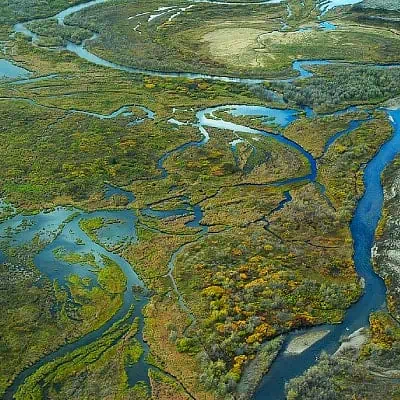
Though this topic is often contested (even amongst the scientific community!), there are, overall, dozens of types of wetlands that can be defined within several main categories nestled within five classes. These categories and classes were developed in 1979 by four wetland scientists with the U.S. Fish and Wildlife Service (USFWS), based on extensive data collection and strict criteria. The Cowardin System, as this classification system is known, clearly defines a wetland as:
“…lands transitional between terrestrial and aquatic systems where the water table is usually at or near the surface or the land is covered by shallow water. For purposes of this classification wetlands must have one or more of the following three attributes: (1) at least periodically, the land supports predominantly hydrophytes 1; (2) the substrate is predominantly undrained hydric soil; and (3) the substrate is nonsoil and is saturated with water or covered by shallow water at some time during the growing season of each year.”
There are many, many different classification systems for wetlands (hence the frequent confusion and contention!). As the USFWS is responsible for classifying wetlands in the U.S. and they utilize the Cowardin System, and Europe and South America both use around half a dozen different classification systems, we’ll stick with the Cowardin System for ease and clarity as its criteria can be applied to identifying wetland systems worldwide.
The Cowardin System (How Are Wetlands Classified?)
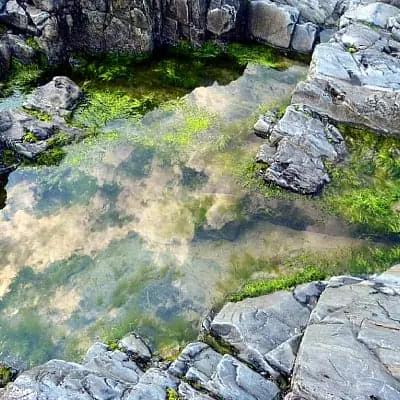
There are five primary classes of wetland systems. These are: marine, estuarine, riverine, lacustrine, and palustrine. Each of these classes contains multiple sub-types, which make up the wetlands that most of us are familiar with (marshes, bogs, fens, mangrove swamps, tidal ponds and tidal marshes, vernal pools, and so on).
A marine wetland is just what it sounds like – a wetland that exists along the open ocean. These occur when the seawater is able to escape over the continental shelf onto the shoreline, usually due to tidal shifts, large waves, or underground channels. Per the Cowardin System, to be considered a marine wetland, the wetland must be exposed to all that the open ocean has to offer, including currents, waves, storms, and the like, and salinity must be 30 or more parts per thousand (ppt), meaning there is virtually no dilution from freshwater. Examples of marine wetlands include tidal pools and shallow coastal bays with little to no freshwater flow.
An estuarine wetland is similar to a marine wetland, but access to the open ocean is much more limited and its waters are at least somewhat diluted by freshwater. They are partially enclosed by land, and salinity can range between .5 and less than 30 ppt depending on distance from the ocean, time of day, and season. Examples of estuarine wetlands include estuaries (as the name implies), lagoons, and mangrove swamps (technically called “mangrove forest wetlands”). Both marine and estuarine wetlands are collectively known as “coastal wetlands.” Coastal wetlands consist of some of the most rare and distinctive biodiversity in the world thanks to their incredibly rare conditions that can vary greatly depending on the time of day, the season, or even from individual tidal pool to tidal pool!
Riverine wetlands, as might be guessed, are wetlands contained within a river system, channel, or river basin. The exception here is if the wetland is heavily dominated by trees, shrubs, and other terrestrial plant life (making it a forested wetland), or if salinity is greater than .5 ppt (making it a coastal wetland). There are some more technical qualifications for this class of wetland system, but we’ll leave those out for clarity’s sake. You can read more about them on page 15 of this USFWS document.
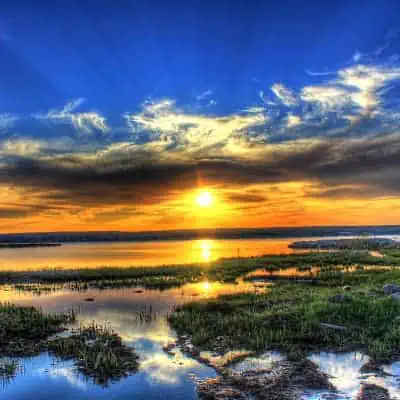
Lacustrine wetlands, according to the Cowardin System, are “situated in a topographic depression or a dammed river channel,” have trees or shrubs with less than 30% canopy coverage (meaning they’re either well-spaced apart or not mature), and in most cases must have an area greater than 8 hectares or 20 acres. In most cases, there is a noticeable amount of wave action. Additionally, they can be fed by either fresh or saltwater, but salinity must be less than .5 ppt. They can often be found along the outskirts of lakes. Examples of lacustrine wetlands include massive Lake Superior (or rather, the countless wetlands found along its expansive perimeter), permanently flooded reservoirs, playa lakes, and tidal lakes.
Palustrine wetlands can either be tidal or nontidal so long as salinity is less than .5 ppt, and are dominated by trees, shrubs, and other emergent vegetation (including certain species of lichen and mosses). The latter can be lacking, but only if the wetland is less than 8 hectares, it does not have a bedrock shoreline or one formed by waves, and its deepest part is less than 2.5 meters at low water. Examples of palustrine wetlands include some of the most widely known wetlands: bogs, fens, swamps, and marshes. This brings us to our next section…
The Primary Wetland Types
Now that we’ve given you some background on how wetlands are classified, let’s delve into the most well-known wetland types! Just as the classes discussed above, each of these wetland types contains multiple sub-categories, as well. This is by no means an exhaustive list.
1) Bog

Bogs are characterized by the presence of acidic soil and water, and are dominated by mosses belonging to the genus Sphagnum. The exact composition of a bog can differ; some have over a meter of thick sphagnums covering meters of water (making them dangerous to walk across even if the “ground” seems sturdy and safe), while others can be almost completely dry, or the only moisture contained within the sphagnum itself. This is because bogs depend on precipitation for their water content, and as such can differ seasonally or even year to year. Once precipitation occurs, sphagnums and peat mosses can bounce back readily and will contain as much as 70% water for many, many months even if drought strikes.
Over centuries, sphagnum mosses break down into peat, which is why some bogs are commonly called sphagnum bogs and some are called peat bogs, depending on their stage of succession. The pocosin is another type of bog, which typically lacks much standing water and hosts often entirely different plant and animal life than sphagnum and peat bogs.
Since bogs depend on rainwater and snow rather than runoff or groundwater, they are severely lacking in nutrients, which makes them incredibly unique ecosystems in which only very particular plants and animals are able to thrive. Again, these will differ from bog to bog. Examples of organisms found in bogs are those that are tolerant of acidic, low-nutrient conditions, including: cranberry, blueberry, leatherleaf, bog laurel, bog rosemary, carnivorous plants like pitcher plants, various ants, some salamander and snake species, beaver, muskrats, and cervids like moose depending on the exact location. Sometimes, bear may visit bogs to harvest berries. Due to the low oxygen content of the water in bogs, there are very rarely any fish.
2) Fen
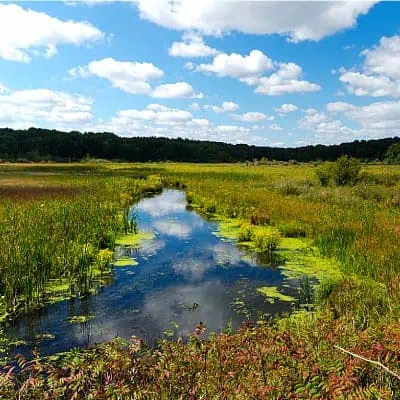
Almost the exact opposite of bogs in definition, fens receive their moisture from sources other than precipitation, such as runoff, groundwater, and small streams that flow through them. Due to the rich nutrients and minerals they receive from these water sources, fens tend to be more on the alkaline side, and can have calcium-rich soils. These soils, and the fen itself, can take as long as 10,000 years to form!
Interestingly, sphagnum mosses can also be found in some fens – it just depends on the species of sphagnum, as there are hundreds of them! Over a great deal of time, these mosses can, as mentioned previously, break down to form peat, which in turn blocks nutrient and water flow and can result in the fen becoming a bog.
Fens, like all wetlands, are incredibly important for controlling flooding, filtering water, and providing much-needed habitat for uncommon and often struggling plant and animal species. Examples of these in a fen, depending on the location, typically includes sedges (the dominant plant type), many frog species, ground-nesting and passerine birds, rushes, unique wildflowers like orchids, beavers, and a number of endangered species – including the very misunderstood Eastern massasauga rattlesnake in the Midwestern U.S., and the Eurasian bittern in portions of Europe.
3) Swamp
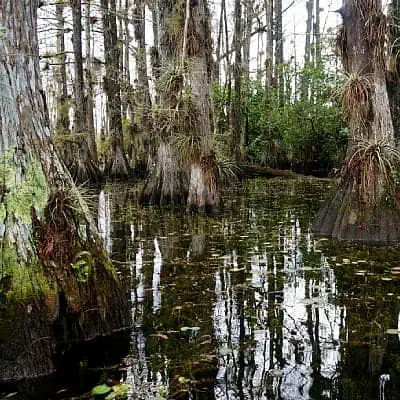
Swamps – perhaps the most well-known and misunderstood wetland of them all! Throughout both American and European history, swamps were looked at as stinky, bug-ridden, disease-infested wastelands. However, though bugs do quite enjoy a good swamp, nothing could be farther from the truth! Swamps are incredibly productive ecosystems that greatly protect us from flooding while also filtering water, soaking up excess nutrients, and providing extremely rich soils for a massive host of diverse plant and animal life.
Swamps are, in short, any wetland that is dominated by trees and shrubs. There are many types of swamps, including mangrove swamps, northern hardwood swamps, lowland swamps, and shrub swamps, among others. Species such as various tree-dwelling ducks, river otters, many snakes and frogs, cypress, alder, willows, dogwoods, a myriad of insects that countless animals depend on, and many, many others depending on the location and type of swamp all rely on these critical ecosystems – including humans!
In fact, historically New Orleans was surrounded by vast wooded swamps and bayous that protected the area from hurricane-level wind and water, and it wasn’t until over 50% of these were filled in and/or dammed that the city began experiencing massive issues with regular flooding and gradually sinking below sea level. Similarly, southern Florida has been experiencing greater issues with flooding, as well as significantly less access to clean drinking water, as the Everglades (technically a marsh) continually disappear.
4) Marsh

Marshes are wetlands that are constantly saturated and dominated by soft, rather than woody, emergent plant life that has adapted to life in the water. There are typically plenty of nutrients, minerals are abundant, and marsh pH is usually neutral. Marshes can be either tidal or non-tidal, meaning that they can contain either fresh or saltwater (so long as salinity is less than .5 ppt) and exist either inland or on shorelines. Their soils can be silt, sand, clay, or any combination thereof, with water ranging in depth from a couple of inches to several feet.
Two of the primary services conducted by a marsh are helping to replenish groundwater and streams during droughts, while soaking up excess water to prevent flooding during times of extreme precipitation. The vegetation in a marsh greatly slows down water flow, allowing sediment and excess nutrients (such as those from fertilizers) to sink over time to the bottom of the marsh and be utilized by its plants rather than being carried to other habitats or populated areas that wouldn’t be able to handle such a concentration of them. In fact, marshes are characterized as one of the most productive and beneficial ecosystems on the planet!
Bulrushes, lily pads, pickerelweed, various reeds, some fish, herons, mink, otters, countless migratory species of waterfowl, shorebirds (in the case of tidal marshes), and many others depend on marsh habitats. Examples of marshes include the Everglades and prairie potholes in the U.S., the Pinsk marshes of Belarus and Ukraine, and the Camargue marshes of southern France.

